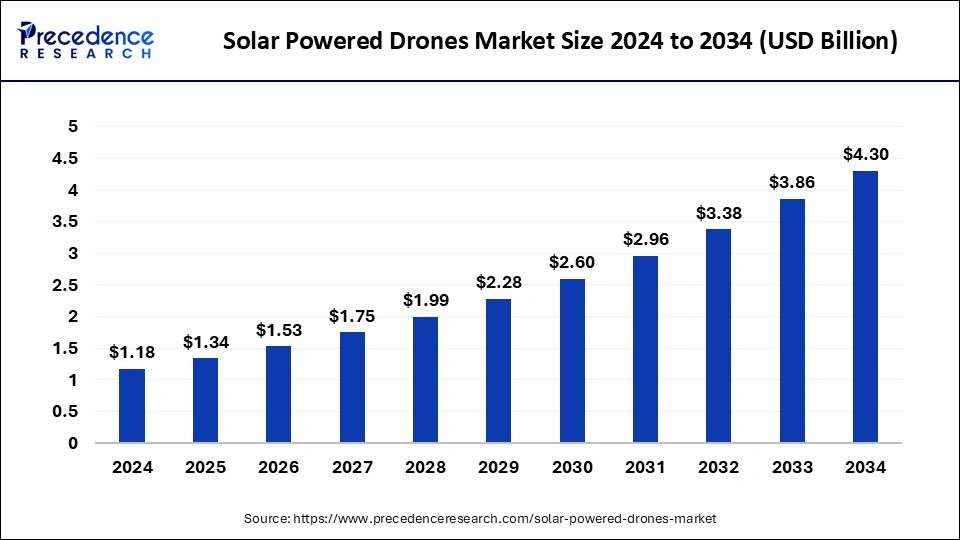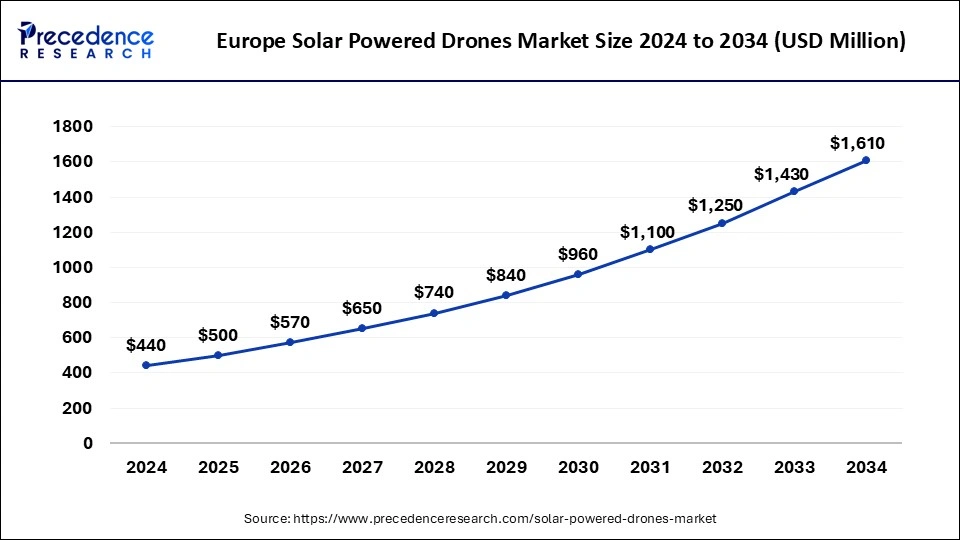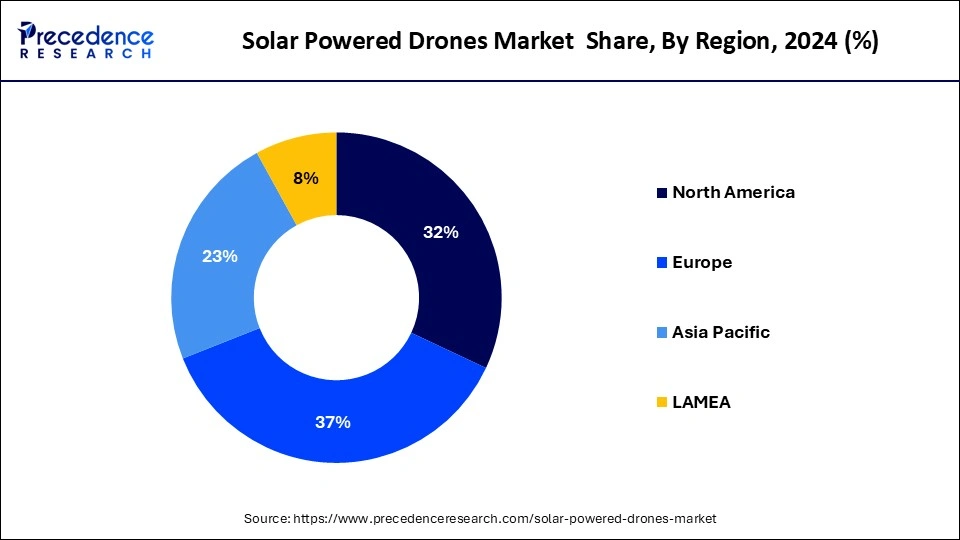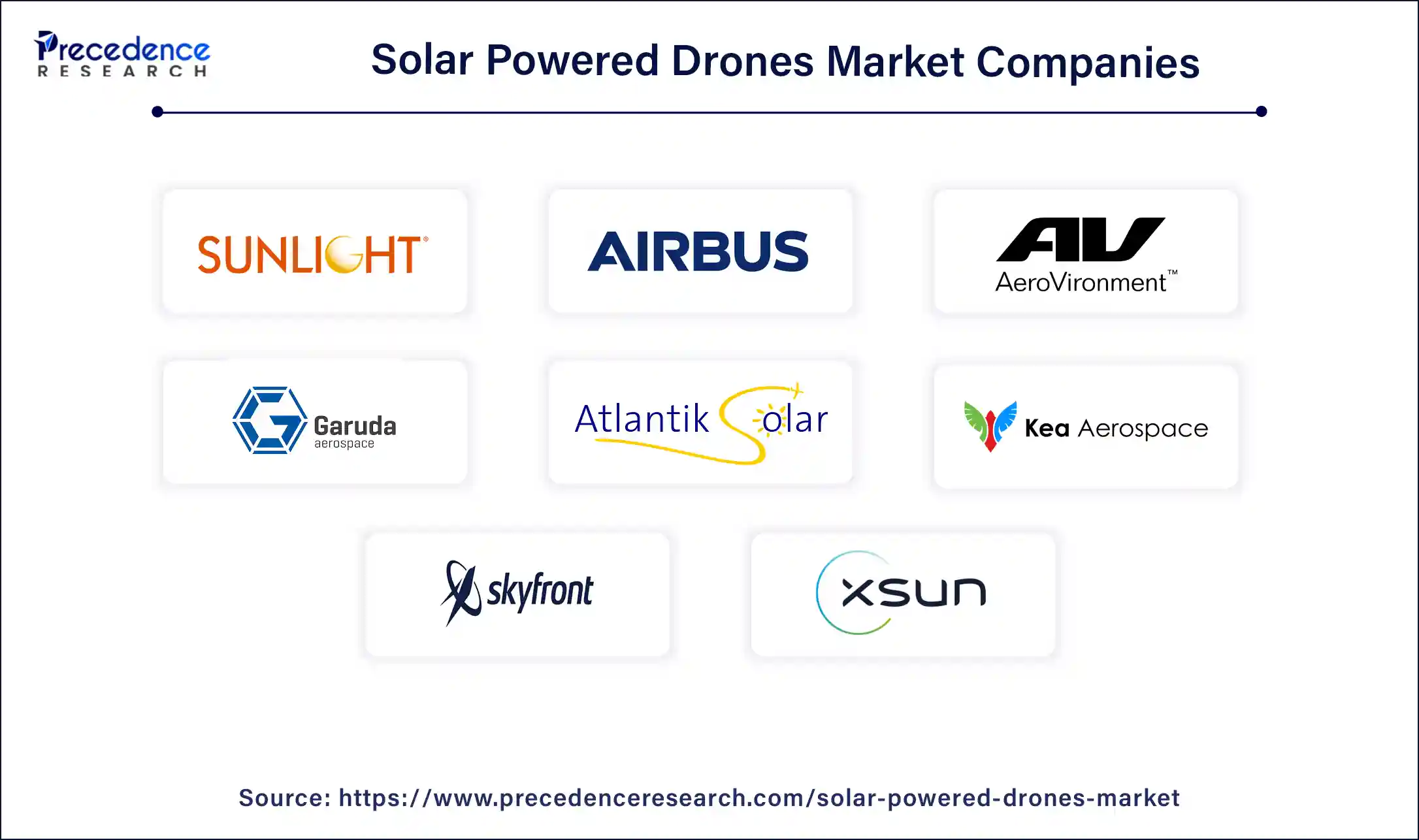February 2025
The global solar powered drones market size is calculated at USD 1.34 billion in 2025 and is forecasted to reach around USD 4.30 billion by 2034, accelerating at a CAGR of 13.80% from 2025 to 2034. The Europe solar powered drones market size surpassed USD 500 million in 2025 and is expanding at a CAGR of 13.85% during the forecast period. The market sizing and forecasts are revenue-based (USD Million/Billion), with 2024 as the base year.
The global solar powered drones market size was estimated at USD 1.18 billion in 2024 and is predicted to increase from USD 1.34 billion in 2025 to approximately USD 4.30 billion by 2034, expanding at a CAGR of 13.80% from 2025 to 2034. Increasing adoption of renewable energy sources to maintain a balanced climatic condition and rising technological advancement in the drones manufacturing sector so that it can be applicable across various industries are the major factors driving the market’s growth exponentially.

The Europe solar powered drones market size reached USD 440 million in 2024 and is expected to be worth around USD 1,610 million by 2034, at a CAGR of 13.85% from 2025 to 2034.

Europe held the largest share of the solar powered drones market in 2024. Europe's stringent environmental regulations and commitment to reducing carbon emissions encourage the adoption of green technologies, including solar-powered drones. Europe is home to many top-tier universities and research institutions focusing on renewable energy and aerospace technologies, fostering innovation in solar-powered drones. Europe has a well-established aerospace sector with major players like Airbus and Thales, which are heavily investing in the development and commercialization of solar-powered drones.
North America is observed to grow at the fastest rate during the forecast period in the solar powered drones market, largely due to its advanced technological infrastructure and significant investment in research and development. The presence of leading drone manufacturers and tech companies in the United States fosters innovation and rapid commercialization of new technologies. Moreover, the region benefits from favourable regulatory frameworks and substantial funding from both government and private sectors, supporting the growth of the drone industry. The diverse applications of solar-powered drones in agriculture, environmental monitoring, surveillance, and logistics further drive market expansion. Additionally, North America's varied climate conditions provide an ideal testing ground for improving the resilience and efficiency of solar-powered drones, ensuring they meet the demands of different environments.

China, with its robust manufacturing capabilities and large-scale production, plays a pivotal role in this expansion. The country is heavily investing in solar-powered drone research and development, aiming to enhance capabilities and reduce costs. Additionally, the diverse applications of drones in agriculture, infrastructure monitoring, and disaster management across various Asian countries contribute to the increasing demand. The region's focus on sustainable development and addressing environmental challenges further accelerates the adoption of solar-powered drones, positioning Asia as a critical growth hub in the global solar powered drones market.
Solar powered drones market is witnessing rapid surge in the demand owing to its sustainability and long endurance for unmanned aerial vehicles-UAVs has risen since a couple of past years. Solar powered drones are basically a system of UAVs which uses solar energy to operate as their initial source. These drones have solar panel attached to it. These panels capture the sunlight then convert this energy into the electrical energy which in turn aids in powering the onboard payloads as well as propulsion system.
Since these solar powered drones uses energy of the sunlight, it extends the endurance of flight and also reduce carbon emission that can harmfully impact an environment. Solar powered drones have a number of applications in various sectors such as, surveillance, monitoring systems, climate monitoring and analysis, agriculture, mapping etc. Due to the spectrum such wide applications, the solar powered drones market poised to grow significantly with fastest growing CAGR during the forecasted years on a global level.
| Report Coverage | Details |
| Market Size by 2034 | USD 3.86 Billion |
| Market Size in 2025 | USD 1.18 Billion |
| Growth Rate from 2025 to 2034 | CAGR of 14.12% |
| Largest Market | Europe |
| Base Year | 2024 |
| Forecast Period | 2025 to 2034 |
| Segments Covered | Type, Application, and Regions |
| Regions Covered | North America, Europe, Asia-Pacific, Latin America, and Middle East & Africa |
Prolonged flight duration system
The major driver for the solar powered drones market is prolonged flight duration system achieved by using complex yet efficient system of technologically advanced sensors to give precise output and ensure autonomous flight for extended period. Solar powered drones with extended flight duration attracts the major key players and manufacturing industries which holds potential to drives the market globally. To achieve extended flight duration for drones a conventional method used is increasing the number of batteries which can increase the energy storage capacity, but it will create a load of extra weightage due to overburden of batteries resulting into less duration of drones' flight. While the solar powered panel can be installed onboard reducing the limitations of energy storage and captures sunlight in maximum amount. This in turn, gaining a traction in the market as it also meets the stringent regulations set by authorities for cleaner energy and reduce carbon emission.
Hence, major key players in the market are increasing their efforts to develop the solar powered stratospheric aircraft or drones which are usually unmanned aerial vehicles that works autonoumsly while using a solar energy as a primary energy source to extend their flight duration. For instance, in April 2023, anew-Zealand based tech giant known as Kea Aerospace launched a solar powered stratospheric aircraft named ATMOS MK1. It has capacity for long endurance flights and data collection systems from high altitude.
Climate dependency and feasibility of drones
The major restraint for solar powered drones market is vulnerability of climatic conditions and dependency of these drones on it, eventually affecting the feasibility of the solar powered drones. Despite of the innumerous benefits of solar powered drones, there are some major setbacks that need to be resolve which are a restraining factor of the market.
Solar-powered drones rely on sunlight to generate the necessary energy for operation, making them highly susceptible to weather variations. In regions with frequent cloud cover, rain, or limited sunlight, the efficiency and performance of these drones can be severely hindered. Furthermore, seasonal variations and geographic differences in solar irradiance also impact the viability of solar-powered drones. This dependency on favourable weather conditions limits their reliability and consistent performance, posing a substantial challenge to market growth and broader adoption in diverse global regions.
Real-time monitoring
Solar powered drones provide significant advantages for long-duration missions, including border surveillance, wildlife monitoring, and infrastructure inspection, owing to their extended flight capabilities powered by solar energy. The increasing need for continuous and real-time monitoring in areas such as security, environmental protection, and disaster management fuels this growth. Solar-powered drones are particularly beneficial in remote or difficult-to-access regions, where traditional surveillance methods are challenging or cost-prohibitive. Moreover, advancements in drone technology and sensor integration enhance their effectiveness, driving further adoption and expansion in this crucial market segment.
The solar powered drones market, the Vertical Take-Off and Landing (VTOL) drones segment dominates globally. VTOL drones offer the unique advantage of being able to take off and land vertically, eliminating the need for runways and allowing for deployment in confined environments. This versatility makes them ideal for a wide range of applications, from military operations and emergency response to agricultural monitoring and urban surveillance. The ability to hover, perform precise maneuvers, and transition smoothly between vertical and horizontal flight enhances their operational flexibility and efficiency. As technological advancements continue to improve the endurance and performance of solar-powered VTOL drones, their dominance in the market is expected to grow further, driven by increasing demand for adaptable and efficient aerial solutions.
On the other hand, the fixed-wing segment is one of the fastest-growing segments in the solar powered drones market. Fixed-wing drones are known for their superior flight endurance and efficiency, making them ideal for long-range missions such as environmental monitoring, agricultural surveying, and large-scale mapping. These drones can cover vast areas with minimal energy consumption, which is significantly enhanced by solar power, allowing for extended flight times without the need for frequent recharging or refuelling.
Therefore, the increasing demand for reliable and cost-effective solutions for data collection and surveillance over large geographical areas is driving the growth of the fixed-wing segment. As technology advances, improving the efficiency and capabilities of solar-powered fixed-wing drones, their adoption across various industries is expected to accelerate, solidifying their position as a rapidly expanding market segment.
The agriculture segment held a significant share of the solar powered drones market. These drones provide farmers with innovative solutions for crop monitoring, soil analysis, and precision agriculture. By utilizing solar energy, they can perform prolonged flights, covering extensive farmland without the need for frequent recharging, which is particularly beneficial in large agricultural areas. Solar-powered drones help optimize the use of resources by providing detailed aerial imagery and data on crop health, irrigation needs, and pest infestations, enabling farmers to make informed decisions and improve yields. The increasing emphasis on sustainable farming practices and the adoption of advanced technologies in agriculture drive the demand for solar-powered drones, making this segment one of the most dynamic and rapidly expanding in the market.
While the military segment is observed to grow at a robust pace in the solar powered drones market. These drones offer strategic advantages such as extended flight endurance, reduced dependency on fuel supplies, and enhanced stealth capabilities, making them invaluable for establishing reconnections surveillance, and communication missions. Solar-powered drones can operate for extended periods without needing to return to base for refuelling, providing continuous surveillance and intelligence gathering capabilities in remote or hostile environments.
Additionally, their ability to carry various payloads, including cameras, sensors, and communication equipment, further enhances their utility in military applications. As defence agencies worldwide seek innovative and sustainable solutions to address evolving security challenges, the demand for solar-powered drones in the military sector is expected to continue growing rapidly, driving significant expansion within this market segment.

By Type
By Application
By Geography
For inquiries regarding discounts, bulk purchases, or customization requests, please contact us at sales@precedenceresearch.com
No cookie-cutter, only authentic analysis – take the 1st step to become a Precedence Research client
February 2025
January 2025
November 2024